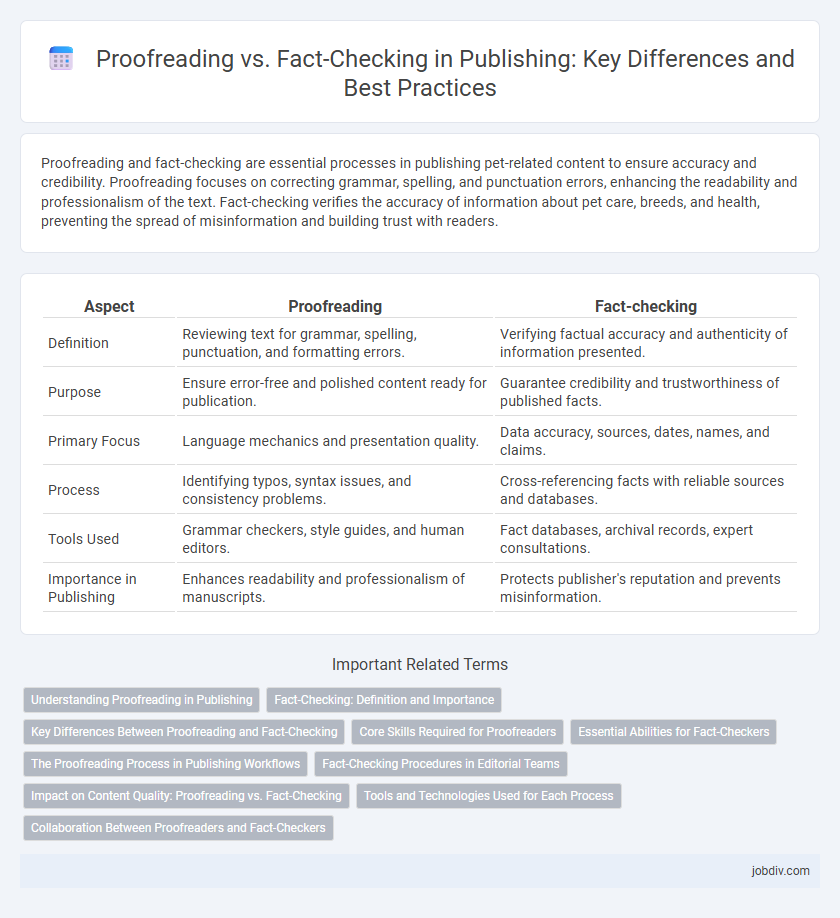Proofreading and fact-checking are essential processes in publishing pet-related content to ensure accuracy and credibility. Proofreading focuses on correcting grammar, spelling, and punctuation errors, enhancing the readability and professionalism of the text. Fact-checking verifies the accuracy of information about pet care, breeds, and health, preventing the spread of misinformation and building trust with readers.
Table of Comparison
| Aspect | Proofreading | Fact-checking |
|---|---|---|
| Definition | Reviewing text for grammar, spelling, punctuation, and formatting errors. | Verifying factual accuracy and authenticity of information presented. |
| Purpose | Ensure error-free and polished content ready for publication. | Guarantee credibility and trustworthiness of published facts. |
| Primary Focus | Language mechanics and presentation quality. | Data accuracy, sources, dates, names, and claims. |
| Process | Identifying typos, syntax issues, and consistency problems. | Cross-referencing facts with reliable sources and databases. |
| Tools Used | Grammar checkers, style guides, and human editors. | Fact databases, archival records, expert consultations. |
| Importance in Publishing | Enhances readability and professionalism of manuscripts. | Protects publisher's reputation and prevents misinformation. |
Understanding Proofreading in Publishing
Proofreading in publishing involves meticulously reviewing a manuscript to identify and correct spelling, grammar, punctuation, and formatting errors, ensuring the text is polished and error-free before final printing. It focuses on the surface-level accuracy of the content rather than the factual integrity of the information presented. This crucial step enhances readability and maintains the professional quality of published works, distinct from fact-checking, which verifies the accuracy of factual data.
Fact-Checking: Definition and Importance
Fact-checking is the process of verifying information accuracy, sources, and data reliability to ensure factual integrity in published content. It prevents the dissemination of misinformation and enhances the credibility of books, articles, and journals by confirming dates, quotes, statistics, and claims. Essential in academic and journalistic publishing, fact-checking fosters reader trust and protects publishers from legal and reputational risks.
Key Differences Between Proofreading and Fact-Checking
Proofreading focuses on correcting grammar, spelling, punctuation, and formatting errors to ensure a polished final text, while fact-checking verifies the accuracy and authenticity of factual information such as dates, names, statistics, and claims. Proofreading targets surface-level mistakes that affect readability, whereas fact-checking involves in-depth research to confirm the validity of content. Both processes are essential in publishing to maintain credibility and quality, but they serve distinctly different purposes in content preparation.
Core Skills Required for Proofreaders
Proofreaders require a keen eye for detail, exceptional command of grammar, punctuation, and spelling, alongside strong language skills to identify and correct typographical errors. Critical thinking and concentration are essential for maintaining consistency and ensuring text accuracy without altering the author's voice. Familiarity with style guides such as APA, MLA, or Chicago Manual of Style enhances their ability to deliver polished, publication-ready manuscripts.
Essential Abilities for Fact-Checkers
Fact-checkers must possess exceptional research skills, enabling them to verify information accurately and efficiently. Attention to detail and critical thinking are crucial for evaluating sources and identifying inconsistencies. Familiarity with digital tools and databases enhances fact-checkers' ability to cross-reference data and ensure content integrity in publishing.
The Proofreading Process in Publishing Workflows
The proofreading process in publishing workflows involves meticulously reviewing the final manuscript to identify and correct typographical errors, spelling mistakes, punctuation inaccuracies, and formatting inconsistencies. Proofreaders use style guides such as the Chicago Manual of Style or AP Stylebook to ensure consistency and adherence to publishing standards. This critical step precedes the printing or digital release, guaranteeing polished, error-free content that enhances the publication's credibility and reader experience.
Fact-Checking Procedures in Editorial Teams
Fact-checking procedures in editorial teams involve verifying the accuracy of all factual information, including dates, statistics, names, and quotes, by consulting reliable primary and secondary sources. Editors use specialized databases, official records, and subject matter experts to ensure content credibility and prevent misinformation. This rigorous process complements proofreading by focusing specifically on the integrity of content rather than grammar or spelling errors.
Impact on Content Quality: Proofreading vs. Fact-Checking
Proofreading enhances content quality by eliminating grammatical errors, typos, and punctuation mistakes, ensuring clarity and professionalism. Fact-checking significantly boosts credibility by verifying the accuracy of facts, data, and sources, preventing misinformation. Both processes are essential; proofreading refines readability, while fact-checking maintains trustworthiness in publishing.
Tools and Technologies Used for Each Process
Proofreading relies heavily on advanced grammar and spelling tools like Grammarly, ProWritingAid, and Microsoft Editor to catch errors and improve text clarity. Fact-checking utilizes specialized databases, AI-powered verification platforms such as FactMata and ClaimBuster, and cross-referencing software that scans multiple sources for accuracy. Integration of Natural Language Processing (NLP) technology enhances both processes by increasing speed and precision in identifying content discrepancies.
Collaboration Between Proofreaders and Fact-Checkers
Collaboration between proofreaders and fact-checkers enhances publishing accuracy by combining linguistic precision with content verification. Proofreaders focus on grammar, syntax, and formatting errors, while fact-checkers verify the authenticity and reliability of information. This synergy ensures published materials are both error-free and factually sound, reinforcing credibility and reader trust.
Proofreading vs Fact-checking Infographic

 jobdiv.com
jobdiv.com